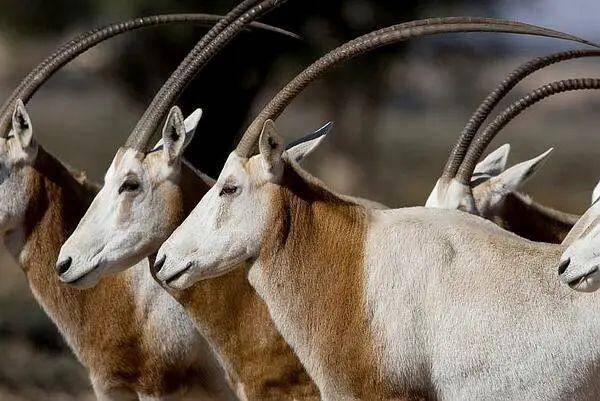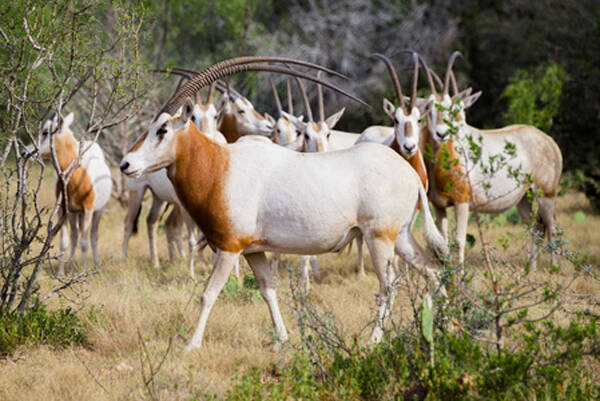Oryx dammah
IUCN
LCBasic Information
Scientific classification
- name:Oryx dammah
- Scientific Name:Oryx dammah,Scimitar-horned oryx,Scimitar-horned oryx, white oryx, white oryx, scimitar-horned oryx, scimitar-horned oryx
- Outline:Ungulata
- Family:Artiodactyla Bovidae Oryx
Vital signs
- length:160-175cm
- Weight:180-200kg
- lifetime:15-21years
Feature
The horns are long and curve backwards like a scimitar.
Distribution and Habitat
Distributed in Algeria, Burkina Faso, Chad, Egypt, Libya, Mali, Mauritania, Morocco, Niger, Nigeria, Senegal, Sudan, Tunisia, Western Sahara.
It inhabits desert areas, areas between true deserts and the Sahel, where annual rainfall is less than 350 mm, and lives all year round in hot and dry arid and semi-arid zones, sand dunes, wooded depressions between dunes and grasslands.
Appearance
The scimitar-horned oryx is 160-175 cm long; 110-125 cm tall at the shoulder; 45-60 cm long tail; and weighs 180-200 kg. Like other oryx species, there are black stripes on the forehead extending to the nose, like a black and white mask. However, in this species, the black tends to turn brown. The fur is white, the chest is reddish brown, and the basic color from the neck to the chest is white and rusty brown. There are brown stripes on the sides of the body, and a rusty reddish brown patch on the thigh. Both sexes have horns, which are very long and curved backwards like a scimitar. The horns of both males and females can be up to 100-125 cm long. The horns are long and thin and often break off.
Strong physique; legs suitable for long-distance running; 4 toes on the feet, but the lateral toes are more degenerate than those of deer, suitable for running; incisors and canines are degenerate, but the lower incisors are retained, the lower canines are incisorized, and the three pairs o
Details
Scimitar-horned oryx (scientific name: Oryx dammah) is called Scimitar-horned oryx in English. It has no subspecies. It was discovered in 1816 and named by biologist Philipp Jakob Cretzschmar in 1827.

Scimitar-horned oryx are active in the early morning and evening, usually gathering in groups of more than 10, forming a group of about 40 to migrate. They migrate to the north in the rainy season and back in the dry season. The oryx is usually centered on a strong adult male oryx, leading several female oryxes and young oryxes to live together. These male oryxes provide guidance on the time and location of the oryx's movement. They maintain a strict marching formation, with stragglers relentlessly pursuing the group. Unlike other oryxes, lone male scimitar-horned oryxes are rarely seen. Male scimitar-horned oryxes frequently engage in combat. However, these confrontations are carefully choreographed and rarely end in bloodshed, unless competition for vital resources is intense. Male scimitar-horned oryxes engage in combat in a similar pattern to mating circles, with the inferior male lowering his head below the dominant male's as a sign of defeat and submission.
Scimitar-horned oryxes are herbivores that feed on annual herbs, succulent roots and shoots of herbs, and fruits and vegetables that have lost their moisture. Like most species of arid environments, they are subject to unpredictable and variable rainfall. Due to their highly nomadic nature, the scimitar-horned oryx will travel many kilometers in search of new green grasses that sprout rapidly. Although they tend to stay in small groups of 40 or so, when food is scarce and concentrated, they can form a herd that outnumbers hungry animals. They can survive for weeks without water because their kidneys prevent water loss and control body temperature to avoid sweating.

The breeding season of the Scimitar-horned Oryx is from March to October. It can breed once a year. The female gestation period is 9 months. Each litter has 1 cub. The probability of having 2 cubs is extremely rare, with a probability of 0.7%. The total weight of the newborn cubs is 9-15 kg. The lactation period is about 3.5 months. Sexual maturity is achieved at 1.5-2 years old. Scimitar-horned oryx in captivity generally live to around 15 years old, with the record being a female 21 years old kept at the Smithsonian National Zoo in the United States.
The scimitar-horned oryx was used as a food source in the past, but today its most valuable contribution may be its place in ecotourism. Both Africa and the United States have benefited greatly from the rise of this new type of tourism. Although the range of the scimitar oryx has been greatly reduced, especially in the north, their numbers have remained relatively high due to the large numbers living in enclosures. Several large game reserves, mainly in Texas, have initiated successful programs to breed scimitar-horned oryx. However, its habitat is being destroyed and reintroduction of large numbers of the species may be difficult.
There were plans to breed scimitar-horned oryx in the 1960s. In 1996, there were 2,145 scimitar-horned oryxes in Texas, USA, and at least 1,250 in zoos and parks elsewhere. A population has been preserved in Tunisia and is expanding into the wild.
Listed in the 2016 IUCN Red List of Endangered Species Ver 3.1 - Extinct in the Wild (EW).
Protect wildlife and stop eating game.
Maintaining ecological balance is everyone's responsibility!








